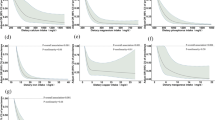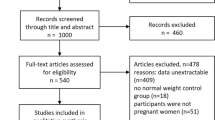Abstract
Background/objectives
Preterm birth is a global public health priority related to maternal nutrition. The effect of maternal calcium intake during pregnancy on preterm birth is inconclusive and data is lacking in China. We aimed to estimate the role of calcium intake from diet and supplements on preterm birth in the Chinese population.
Methods
We used data of 7195 women from a large-scale cross-sectional study in Northwest China. Dietary intake was evaluated via a validated food frequency questionnaire, and other information was collected by a structured questionnaire. Generalized estimating equation models were used to estimate the relationship between calcium intake and preterm birth.
Results
Inadequate dietary calcium intake was universal in our population (85.9%), and no association was found between daily dietary calcium intake and preterm birth. Maternal calcium supplementation was significantly associated with reduced risk of preterm birth (OR 0.72, 95% CI 0.60, 0.87, P = 0.001), particularly among women who commenced calcium supplementation in the second and third trimester of pregnancy with longer duration (OR 0.62, 95% CI 0.42, 0.91, P = 0.015). Higher daily calcium intake from supplements was linked with lower preterm birth risk (every 100 mg increase: OR 0.87, 95% CI 0.79, 0.96, P = 0.004). There is a negative association between daily total calcium intake and preterm birth among calcium supplement users (every 100 mg increase: OR 0.91, 95% CI 0.84, 0.97, P = 0.007).
Conclusions
In conclusion, appropriate calcium supplementation during pregnancy could be beneficial in the prevention of preterm birth, and it might be suitable for implementing in low calcium intake areas of China.
This is a preview of subscription content, access via your institution
Access options
Subscribe to this journal
Receive 12 print issues and online access
$259.00 per year
only $21.58 per issue
Buy this article
- Purchase on Springer Link
- Instant access to full article PDF
Prices may be subject to local taxes which are calculated during checkout
Similar content being viewed by others
References
Blencowe H, Cousens S, Oestergaard MZ, Chou D, Moller AB, Narwal R, et al. National, regional, and worldwide estimates of preterm birth rates in the year 2010 with time trends since 1990 for selected countries: a systematic analysis and implications. Lancet. 2012;379:2162–72.
Frey HA, Klebanoff MA. The epidemiology, etiology, and costs of preterm birth. Semin Fetal Neonatal Med. 2016;21:68–73.
Hofmeyr GJ, Lawrie TA, Atallah AN, Torloni MR. Calcium supplementation during pregnancy for preventing hypertensive disorders and related problems. Cochrane Database Syst Rev. 2018;10:Cd001059.
Blencowe H, Cousens S, Chou D, Oestergaard M, Say L, Moller AB, et al. Born too soon: the global epidemiology of 15 million preterm births. Reprod Health. 2013;10(Suppl 1):S2.
Zou L, Wang X, Ruan Y, Li G, Chen Y, Zhang W. Preterm birth and neonatal mortality in China in 2011. Int J Gynaecol Obstet. 2014;127:243–7.
Zeitlin J, Szamotulska K, Drewniak N, Mohangoo AD, Chalmers J, Sakkeus L, et al. Preterm birth time trends in Europe: a study of 19 countries. Bjog. 2013;120:1356–65.
Lu MS, He JR, Chen Q, Lu J, Wei X, Zhou Q, et al. Maternal dietary patterns during pregnancy and preterm delivery: a large prospective cohort study in China. Nutr J. 2018;17:71.
Belizan JM, Villar J, Repke J. The relationship between calcium intake and pregnancy-induced hypertension: up-to-date evidence. Am J Obstet Gynecol. 1988;158:898–902.
Mosha D, Liu E, Hertzmark E, Chan G, Sudfeld C, Masanja H, et al. Dietary iron and calcium intakes during pregnancy are associated with lower risk of prematurity, stillbirth and neonatal mortality among women in Tanzania. Public Health Nutr. 2017;20:678–86.
WHO. WHO Recommendations on antenatal care for a positive pregnancy experience. Geneva, Switzerland: WHO; 2016.
Omotayo MO, Dickin KL, O’Brien KO, Neufeld LM, De Regil LM, Stoltzfus RJ. Calcium supplementation to prevent preeclampsia: translating guidelines into practice in low-income countries. Adv Nutr. 2016;7:275–8.
Buppasiri P, Lumbiganon P, Thinkhamrop J, Ngamjarus C, Laopaiboon M, Medley N. Calcium supplementation (other than for preventing or treating hypertension) for improving pregnancy and infant outcomes. Cochrane Database Syst. Rev. 2015;2:Cd007079.
Crowther CA, Hiller JE, Pridmore B, Bryce R, Duggan P, Hague WM, et al. Calcium supplementation in nulliparous women for the prevention of pregnancy-induced hypertension, preeclampsia and preterm birth: an Australian randomized trial. FRACOG and the ACT Study Group. Aust N Z J Obstet Gynaecol. 1999;39:12–8.
Villar J, Abdel-Aleem H, Merialdi M, Mathai M, Ali MM, Zavaleta N, et al. World Health Organization randomized trial of calcium supplementation among low calcium intake pregnant women. Am J Obstet Gynecol. 2006;194:639–49.
Goldberg GR, Jarjou LM, Cole TJ, Prentice A. Randomized, placebo-controlled, calcium supplementation trial in pregnant Gambian women accustomed to a low calcium intake: effects on maternal blood pressure and infant growth. Am J Clin Nutr. 2013;98:972–82.
Yang J, Dang S, Cheng Y, Qiu H, Mi B, Jiang Y, et al. Dietary intakes and dietary patterns among pregnant women in Northwest China. Public Health Nutr. 2017;20:282–93.
Bunin GR, Gyllstrom ME, Brown JE, Kahn EB, Kushi LH. Recall of diet during a past pregnancy. Am J Epidemiol. 2001;154:1136–42.
Bosco JL, Tseng M, Spector LG, Olshan AF, Bunin GR. Reproducibility of reported nutrient intake and supplement use during a past pregnancy: a report from the Children’s Oncology Group. Paediatr Perinat Epidemiol. 2010;24:93–101.
Cheng Y, Yan H, Dibley MJ, Shen Y, Li Q, Zeng L. Validity and reproducibility of a semi-quantitative food frequency questionnaire for use among pregnant women in rural China. Asia Pac J Clin Nutr. 2008;17:166–77.
Institute of Nutrition and Food Safety & China Center for Disease Control and Prevention. China Food Composition Book 1. 2nd edn. Beijing: Peking University Medical Press; 2009.
Willett WC, Howe GR, Kushi LH. Adjustment for total energy intake in epidemiologic studies. Am J Clin Nutr. 1997;65:1220S–8S.
RS G. Principles of nutritional assessment. 2nd ed. New York: Oxford University Press; 2005.
Cheng Y, Dibley MJ, Zhang X, Zeng L, Yan H. Assessment of dietary intake among pregnant women in a rural area of western China. Bmc Public Health. 2009;9:222.
Chinese Nutrition Society. Chinese dietary reference intakes 2013. Beijing: Science Press; 2014.
Liu D, Cheng Y, Dang S, Wang D, Zhao Y, Li C, et al. Maternal adherence to micronutrient supplementation before and during pregnancy in Northwest China: a large-scale population-based cross-sectional survey. BMJ Open. 2019;9:e028843.
Anderson JJ, Kruszka B, Delaney JA, He K, Burke GL, Alonso A, et al. Calcium intake from diet and supplements and the risk of coronary artery calcification and its progression among older adults: 10-year follow-up of the multi-ethnic study of atherosclerosis (MESA). J Am Heart Assoc. 2016;5:e003815.
Sterne JA, White IR, Carlin JB, Spratt M, Royston P, Kenward MG, et al. Multiple imputation for missing data in epidemiological and clinical research: potential and pitfalls. Bmj. 2009;338:b2393.
Diez Roux AV. Neighborhoods and health: where are we and were do we go from here? Rev d’epidemiologie et de sante publique. 2007;55:13–21.
Hubbard AE, Ahern J, Fleischer NL, Van der Laan M, Lippman SA, Jewell N, et al. To GEE or not to GEE: comparing population average and mixed models for estimating the associations between neighborhood risk factors and health. Epidemiology. 2010;21:467–74.
He Y, Yang X, Xia J, Zhao L, Yang Y. Consumption of meat and dairy products in China: a review. Proc Nutr Soc. 2016;75:385–91.
Chinese Nutrition Society. Dietary guidelines for Chinese residents. 1 edn. Beijing: People’s Medical Publishing House; 2016.
Booth A, Camacho P. A Closer look at calcium absorption and the benefits and risks of dietary versus supplemental calcium. Postgrad Med. 2013;125:73–81.
Villar J, Repke JT. Calcium supplementation during pregnancy may reduce preterm delivery in high-risk populations. Am J Obstet Gynecol. 1990;163:1124–31.
Wojcicka-Jagodzinska J, Romejko E, Piekarski P, Czajkowski K, Smolarczyk R, Lipinski T. Second trimester calcium-phosphorus-magnesium homeostasis in women with threatened preterm delivery. Int J Gynaecol Obstet. 1998;61:121–5.
Carroli G, Merialdi M, Wojdyla D, Abalos E, Campodonico L, Yao SE, et al. Effects of calcium supplementation on uteroplacental and fetoplacental blood flow in low-calcium-intake mothers: a randomized controlled trial. Am J Obstet Gynecol. 2010;202:45.e1–9.
Wilkins JRBJ. Comparing dietary recall data for mothers and children obtained on two occasions in a case-control study of environmental factors and childhood brain tumors. Int J Epidemiol. 1997;26:953–63.
Willett WC, Sampson L, Browne ML, Stampfer MJ, Rosner B, Hennekens CH, et al. The use of a self-administered questionnaire to assess diet four years in the past. Am J Epidemiol. 1988;127:188–99.
Friedenreich CM, Slimani N, Riboli E. Measurement of past diet: review of previous and proposed methods. Epidemiol Rev. 1992;14:177–96.
Hjartåker A, Andersen LF, Lund E. Comparison of diet measures from a food-frequency questionnaire with measures from repeated 24-hour dietary recalls. The Norwegian Women and Cancer Study. Public Health Nutr. 2007;10:1094–103.
Ortiz-Andrellucchi A, Doreste-Alonso J, Henríquez-Sánchez P, Cetin I, Serra-Majem L. Dietary assessment methods for micronutrient intake in pregnant women: a systematic review. Br J Nutr. 2009;102 Suppl 1:S64–86.
Acknowledgements
The authors are grateful to all women who took part in this research, all health staff who coordinated fieldwork and all investigators who contributed to data collection.
Funding
This research was funded by the National Natural Science Foundation of China (grant number 81230016 and 81202218), the Shaanxi Health and Family Planning Commission (grant number Sxwsjswzfcght2016–013), and the National Key Research and Development Program of China (grant numbers 2017YF0907200 and 2017YF0907201).
Author information
Authors and Affiliations
Contributions
DL, YZ, YC, and HY conceived and designed the study; DL, SL, FL, BM, PQ, BZ, AL, ML, and GS collected and cleared the data; DL, LZ, SD, BM, and PQ analyzed and interpreted the data; DL, SL, FL, SD, YZ, YC, LZ, and HY drafted and revised the paper. All authors read and approved the final version of the paper.
Corresponding author
Ethics declarations
Conflict of interest
The authors declare that they have no conflict of interest.
Ethics approval
This study was approved by the Ethic Review Committee and Academic Committee of Xi’an Jiaotong University Health Science Center (Approval No. 2012008).
Informed consent
Written informed consent was obtained from all participants.
Additional information
Publisher’s note Springer Nature remains neutral with regard to jurisdictional claims in published maps and institutional affiliations.
Supplementary information
Rights and permissions
About this article
Cite this article
Liu, D., Li, S., Lei, F. et al. Associations between maternal calcium intake from diet and supplements during pregnancy and the risk of preterm birth in a Chinese population. Eur J Clin Nutr 75, 141–150 (2021). https://doi.org/10.1038/s41430-020-00701-8
Received:
Revised:
Accepted:
Published:
Issue Date:
DOI: https://doi.org/10.1038/s41430-020-00701-8



